#vs a single linear progression
Explore tagged Tumblr posts
Note
so tell us about velothi philosophy :3c how does it differ, to say, its imperial counterparts? how has it changed across time?
Where to start!! Going to try my hardest to produce a semi-coherent answer here lol
quick note before i get into it— due to the nature of religion in the Elder Scrolls, i’m going to treat theology and philosophy as more or less the same discipline. there will obviously still be some discussions which fall more squarely into one field or the other, but in a world where ‘gods’ are demonstrably real and regularly involving themselves with the affairs of mortals, there’s going to be a great deal more overlap than there is irl.
with that out of the way, i’ll limit my discussion to three main areas of philosophy in which Velothi attitudes differ the most from their Imperial counterparts; (1) the determinism/free will debate, (2) notions of faith vs veneration, and (3) the relationship between religion and morality. This isn’t too long dw but I’ve put it under a read more just in case
1. determinism vs free will
the imperial pantheon being headed by a god of time would, i think, have significantly shaped imperial philosophy. teslore is riddled with prophecies, as well as the Elder Scrolls themselves and ‘heroes’ as a category of beings who are uniquely capable of ruling their own destiny. ignoring the doylist explanation for a moment (that heroes are player characters in an otherwise scripted video game), it is clear that Imperial philosophy is dominated by a deterministic streak.
Velothi philosophy however would fall (imo) more in the compatibilism camp. rather than our futures being predetermined by what is written in the Scrolls, I think the Velothi might say instead that what is written in the Scrolls is determined by what we, in the future, choose to do. ‘Outside of time’ =/= ‘before time’— by which I mean that if the Scrolls truly are from outside of time, it would be nonsensical to conclude that the contents of the scrolls is what causes certain events to then occur— because that would imply some kind of linear progression.
why do i think this? i won’t lie it is 80% headcanon, however the ability of Mephala to ‘pull but a single thread’ and unravel the weave of fate reflects, i think, the central position which the ability to determine one's own destiny holds in Velothi identity. An Imperial philosopher might say that Daedric Princes, like mortals, do not exist ‘outside time’ in the way that Akatosh does, so Mephala’s own actions would themselves be considered pre-determined. But I think the Velothi philosopher here would just cycle back to the compatibilist argument outlined above. Dunmer are a proud and independent people and I think they would strongly resist any attempt to imply that they do not have control over their own actions lol
2. faith vs veneration
Also central to Velothi philosophy and culture is the notion that respect and power must be earned, and i think this would apply to their gods as much as to themselves. Veloth turned away from the Aedra after Boethiah came to him in his dreams and visions. Why dedicate your life to the worship of invisible—and seemingly impotent—gods when the daedra are right there, showing themselves through positive action to be worthy of your fear and your love?
I think the notion of ‘faith’—being a belief in something which cannot be proven, both in spite of and because of that fact—would be dismissed by the Velothi as fanciful and ridiculous— a way for the elite to control the masses. This isn’t to say that they don’t believe in the aedra (there is a text somewhere in Morrowind which suggests that House Redoran, at least, adopted some kind of aedra worship during Imperial occupation), however they wouldn’t consider the aedra worthy of veneration. And Akatosh in the Velothi sense might be understood a little differently— perhaps even as a simple literary device designed to personify what is otherwise just the abstract notion of time.
3. ethics, and the relationship between religion and morality
It’s worth taking care here not to map Christian notions of morality and sin onto the Imperial cult, however there are some broad similarities. The Divines don’t necessarily represent moral virtues, however they all encapsulate some kind of virtue in the more holistic, Aristotelian sense; and the fact they are each virtuous in some way is taken both as reason to worship them and as reason to emulate those characteristics. (Not gonna get into the Euthyphro dilemma, but regardless of which view you think they'd take, it is clear there is some kind of relationship here).
The same cannot be said of the Good Daedra, nor of the Tribunal. Any ‘virtue’ these figures happen to possess is incidental to their status as figures deserving of worship. This is not to suggest that Dunmer have no moral code or care not for virtues such as generosity or benevolence; it’s just that ethics is seen as divorced from divine law (ignoring the above mentioned lore text which says the exact opposite wrt House Redoran ;_;)
At the extreme end of this spectrum you find Telvanni ethics– “According to Telvanni principles, the powerful define the standards of virtue.” Which is very Nietzschean lmao. But I don’t think this would reflect Velothi ethics at large. If I were to summarise, I would say that the Velothi reject any notion of morality as intrinsically good, but that they generally recognise moral virtues as instrumentally valuable. Humility and selflessness in the Alessian, slave-morality sense are rejected, but social cooperation, justice and generosity are rightfully recognised as qualities which lead to the betterment of society overall.
--
given how long this is already i will save the question of how velothi philosophy changes over time for another post :') the Fourth Era transition from tribunal worship to the New Temple is something i'm exploring in my soon-to-be-published little novella hehe. thank you for the ask! <3
and tagging @ervona who expressed some interest in this topic >:)
#ask#teslore#spectrumcore#thanks sasha! <3#sorry if this comes across as a load of pseudo intellectual hogwash i've not studied any non-moral philosophy since A Level :(
83 notes
·
View notes
Text
dreamdoll watchlist ★
youtube
5 Techniques of Every Successful Student
key takeaways:
★ background:
main theme: build the bigger picture first
he talks about trends he notices between his students that are successful vs unsuccessful
threshold concepts: refers to core concepts in a subject where understanding these concepts is key to transforming the way students understand a whole subject.
a threshold concept can be described as transformative (a significant shift in understanding), probably irreversible (difficult to unlearn), integrative (reveals the association between various topics), sometimes bounded (specific to a particular discipline), and potentially troublesome (difficult to grasp, counter-intuitive)
in simple terms: provides a barrier to allow someone to see and understand a topic in a way they were never able to before
example of experiencing a threshold concept is stumbling over a block in the dark and you're suddenly lost and confused, you don't know where you are- disorientated. like when you're listening to the teacher and suddenly, you don't know what they're talking about anymore. when you're reading a book and you don't know what you just read. you lost your way and you don't know how you lost your way.
what we want is to have lightbulb moments more frequently. have more control to increase the speed of our learning. we want to be able ot overcome these threshold concepts as quickly as possible to become a learner who just gets things a lot faster
in order to do that: we fundamentally need to understand: there are a few fundamentals to learning that affects the student.
★ learning
learning is recursive. learning something once and relearning it over and over again. not that we didn't understand it the first time but it's better and easier to understand when you've known the basics/the foundation of. the bigger picture.
and excursive. a learning journey that has allowances for diversions. you can progress through the material and you don't always have to go in a linear line, you can go back and forth, have multiple different ways of learning something. take diversions and side routes to get to the same place of understanding the concept.
what are some techniques that allows us to engage in active learning in a sustainable, consistent way that anyone can start applying?
it's not the techniques itself but the trends they follow aka crafting the bigger picture.
��� attributes of a good learner
1. priming
pre-study. instead of looking a piece of text and learning it, top from bottom straight away. scan it to get a general understanding.
mentally create a framework on how to think about it instead of what to know. read the heading, images, diagrams, questions.
create a mind map on how the big pictures connect to one another.
don't worry about the details.
big picture = easier lightbulb moments = faster threshold concept = faster learning.
2. how to stay active and attentive while in the class:
for those who start to feel drowsy, sleepy, unable to pay attention. think about needing to be aware if someone is about to throw a ball at you. with information, you have to be ready to catch that information that you are consuming.
ask questions, aloud or inside your mind. lots of questions. questions every minute. if you ask a HOW and WHY question, it causes us to relate that question at a higher mastery of knowledge. not only do you want/need to understand a single concept but the relationship that, that has with other multiple related concepts to see how does it fit together.
3. revision within 12 hours of the initial learning event.
the longer you wait, the higher risk that you're going to forget. you reap higher benefits if you were to review the same day rather than 2 days ahead .
reviewing the same day also maximizes SDMC (sleep dependent memory consolidation) aka "studying while you're asleep" your neural pathways that were active during your learning session repeat while you're asleep. think of it as rewinding a tape. this action in the brain causes neural pathways to strengthen with this repetition.
the way you review is important. make sure it highlights, again, the big picture. chunking aka taking the pieces of information from your learning session and priming to connect it all together. like a puzzle. creating a mind map is a good way to do this.
don't try to use too many words. if you don't use words in your notes, this activates parts of the brain that normally would not be activated if you were to use words. make words and sentences a last resort.
make it reasonably minimal. learning comes naturally and authentically. you don't need to write so many notes (ironic bc i'm... taking... notes....). humans are naturally good at learning. adapting. writing too many notes actually reduces cognitive load. aka the confusion we get. confusion is actually good for us. not too much but not too little either.
4. delayed note taking.
instead of taking notes right away, hold it off. keep the information in our heads a bit, think about it, let that confusion come in and let the brain do it's thing. asking those how and why questions
skip the paraphrasing and have simplified notes. in our head, not on paper. it helps the brain to rely on itself rather than on paper. when we get rid of that fear of having to write constantly in order to learn we unlock a huge opportunity for effective learning
5. pre-exam revision.
examine the topics that are most challenging to you. the things you feel the weakest on. make it challenging in a meaningful way. recall it instead of recognizing it.
learn in a way that is different each time. this is the best way to test your knowledge and connection to the subject. if you learn something in the same way every time, you saturate that technique to it's ability. and therefore, you won't have any room to improve/effectively learn.
for example, instead of rereading your notes, try to rewrite them or draw diagrams from your current knowledge aka recall.
another example of a technique is the feyman technique.
16 notes
·
View notes
Text
@whumpmasinjuly day 19! (list your favorite whump blogs)
@haro-whumps - their villains strike true fear into my heart and i absolutely adore the way they don’t shy away from the harsher, nastier sides of any of their characters (including the heroes), making whump that feels deeply complex and conflicting! i love their broken whumpees and sadistic whumpers and deeply human caretakers so much. galo and the group whumpee family are my first beloved whumpee ocs & ren lives rent free in my head as an all-time scary bastard! your ocs have such distinct personalities and struggles and you find such a way to make every single depiction of fear and anguish utterly unique, so every new whumpee feels fresh and exciting!
@much-ado-about-whumping - my goodness, what a fucking exquisite grasp of prose he has! i fell deeply in love with déomas from the moment i met the poor boy (as well your wonderful boy andreas) and every day am envious and admiring of bel’s skill at portraying complicated survivors! i love how you write aftermath as well, with the non-linear healing and gut-punch of lasting trauma making your whump work so unique to me! and god, if there is a mastery of non-con whump (and the realism and thrill and ache of all requisite traumas) you’ve truly grasped it with both utter sensitivity and delightful darkness (and also a profound rethinking of sexual trauma survivors for me in a very real way).
@whump-tr0pes - god, athena, so many books and every one of them rocked me to my core? your characters fucking challenge me so deeply and i love it, and your master of character development and change and growth and regression and everything is just…beautifully broken and incredible. your writing makes me uncomfortable in the best way possible and at the same time satisfied with every little arc - it’s such a gift!
@whumpthisway - first ever whump blog i followed three years ago, has been both a gateway to excellent creators and is very generous with tagging, something i deeply appreciate!
@whumpzone - cerys, your passion for engaging with your audience really warmed my heart when i started following you and i adore how engaged you made your audience feel to participate in your storytelling! you also have one of my favorite caretakers of all time in the wonderful linden! both your series are beloved rereads forever and ever, both of their storytelling progressing and developing so beautifully to natural endings. it’s so goooood.
@ashintheairlikesnow - a titan of this community, i am overawed by the sprawling scope and detail of her worldbuilding. her writing has reminded me again and again how good stories can be when you let your characters influence the world! your depictions of trauma and institutional abuse have impacted me and my thinking quite a lot, no joke, and you have a scary-good ability to capture banal evil.
@secretwhumplair - has an exquisite ability to capture fear, truly enviable how bone-deep their written terror strikes me!
@whumpster-dumpster - keeps churning out creative and inspiring prompts after all this time, i’ve gotten so many good story ideas from red!
@whumping-every-day - though absent for so long, i still absolutely adore her writing & her vampire whump (ash and callum) is absolutely top of the line in visceral brutality!
@whump-me-all-night-long - has such a good ability to balance casts of characters in her stories (my personal favorite being the jewelry box) with distinctive personalities and a wonderful imagination for new ideas!
@wolfeyedwitch - perhaps my personal favorite at writing superhero/villain whump and has such a great ability to capture the trope of team vs. outsider angst!
just a short list of the blogs that i bow in admiration and delight of every day!!! you all are so incredibly talented & i love you! 💖
#all of you get me through the goddamn day with your enthusiasm and excellence and kindness 🥰💖🥰#whump community#not whump#wij23day19#whumpmasinjuly2023
31 notes
·
View notes
Text
for, ahem, no particular reason, i decided to catch up on brilliant minds today instead of watching… other things. so! have a random assortment of brilliant minds thoughts:
the “outed by my phone’s text-to-speech feature while driving a failing patient to the bronx for treatment while my also gay colleague stabs the patient in the eye with a needle i keep in my car” scene in ep 3 was… a lot. medical drama nonsense, yes, but also a lot of fun for me personally.
(i do think this means the show is setting nichols up as a potential romance for wolf, though i don’t have a good sense for whether they’re going to acknowledge that potential in the text soon vs take the slow burn/will they won’t they path. given oliver sacks’ real life ‘shyness’ i think i’d prefer the slow burn, but i’m up for either option.)*
i need me a gif of that classic zq eyebrow reaction, captioned with “🏳️🌈?”
*coming back to this comment after episode 6 and feeling vindicated. i love how self-aware wolf is. saying “i’m not available” and meaning he’s emotionally not in a place to date? not for a lack of interest in this “objectively good-looking guy,” but because he doesn’t want to put a near-stranger through his intimacy issues for a chance at physical intimacy. slow burn, slow burn, slow burn…!
had not noticed the “glory to god” line (in the pilot, when wolf accepts an intern’s offer of half a clonazepam) until i went gifset hunting, and i am a bit :/ about it. are we really taking a real life jewish man and fictionalizing him as christian? like, sure, you’ve also changed the man’s birth year and nation of origin, but those changes were for storytelling convenience. it’s not like zachary quinto is incapable of playing jewish characters.
and the recent flashback with his dad, off his meds, rambling about going out in the woods to protect wolf-the-messiah… yeah, i don’t know about this one, gang.
the flashbacks felt like they were being told out of chronological order the first few episodes, so the more recent ones being a very straightforward linear progression kinda bummed me out… it felt like much blunter storytelling. they also felt increasingly less related to the medical mystery of the week—which, aren’t they supposed to be flashbacks wolf is having during the episode? there should be a connection between the events and the memories—especially in the latest episode, but i acknowledge that a group pregnancy delusion was going to be hard to tie to a single man.
i like the interns quite a bit! the only one i’m still a little uncertain about is jacob (ex-jock); while i think they’re being intentional about him withholding his personal stuff, i still want to learn that personal stuff!! does he really think being a college football player with a death sentence would’ve been a better life than a long-lived doctor? what’s his context that could make that true??
dana (anxious tumblrina) is probably my favorite intern? she’s fun, she’s Very Online, what’s not to like? her panic attack in episode 6 was very well done—this show does a great job of filming to show the subjective perspective in such moments, and her response to the panic attack was even better. felt very real.
i want ericka (‘i’m the real quarterback’) to have more going on than the “i worked so hard for this/never got to have fun” thing. i’m hoping she’s just a private person, and that something more meaty will come up about her eventually.
van (anxious empath) is fine, but i would like for him to stop drawing focus. he’s the only white intern, giving him the potentially big “another neurologist with a neurological condition for wolf to bond with/care for” storyline makes me concerned for this show’s ability to center its characters of color.
also… i do not want intern love triangle. i am worried that either the writing team is trying to build one, or two different writers favor different intern romances and aren’t talking to each other before setting them up with emotional moments. :/ i’m just not into either option. the way both relationships have been written so far feels very much about the guys’ emotions towards ericka, and nothing from ericka herself.
(granted, we haven’t gotten much emotion from ericka in general, see my above comment about her, but even so… this is not a compelling way to introduce a romance. convince me that there is a mutual interest!)
in the “house md but kinder and more diverse” metaphor, carol’s somehow both the wilson “best friend in a different specialty” analog and the cuddy “antagonistic administrator” analog—though she shares the latter role with wolf’s mom. it’s interesting! i don’t know how successfully the show is handling that balance, it’s a bit of a wait-and-see thing right now.
(actually, wait, i may have overlooked this in the pilot: does this fictional hospital have a combined neuro & psych department? is carol wolf’s boss? i guess that would make more sense than a one-man neuro department—and the two specialties do share a medical board in the us…)
i want more of the wolf-carol friendship! i think the weight of their history is well written, their dialogue isn’t written in that clunky “spelling things out for the viewer” way that states things that are obvious to the characters but that are news to the viewers. it’s refreshing. i worry about the “spying for mom” thing, i don’t have a good sense for how seriously the show’s taking it or how much of a betrayal wolf will find it.
5 notes
·
View notes
Text

Interview with Golden Brown (December 2023)
Golden Brown is the work of Stefan Beck. This year, on Inner Islands, he released Weird Choices back in February and Wide Ranging Rider in September. Here we get to hear more about his creative practice and other musical endeavors from this year.
1. What are some recent inspirations?
I was lucky enough recently to see Bela Fleck, Edgar Meyer, Zakir Hussain, and Rakesh Chaurasia play live. It was an absolutely mind blowing performance that I'll carry with me for a long time. Their album As We Speak has been a favorite of mine this year and it was such a treat to see this music live. Four brilliant musicians playing acoustic instruments, they create this amazing sound that is somehow greater than the sum of its parts, even though they are all absolute masters of their instruments. Zakir Hussain is a mad genius of rhythm and the most melody forward percussionist I have ever seen live.
2. You have been playing live a fair bit this year. How has it been translating your pieces into the live realm? Do you take a different approach from the studio versions?
It's been fun trying different approaches with live versions of songs. They do usually take on a different character than the recorded versions. With some of the Wide Ranging Rider songs, this has involved changing from acoustic to electric guitar and incorporating some effects. A few times I've experimented with weaving a few songs into a flowing suite if they are all in the same key/tuning. I try to do things a little differently each time, improvising and changing arrangements. One of my favorite gigs this year was opening for the River Arkansas at the Fox Theater in Boulder. I was lucky enough to have my friends Macon and Robin from the River Arkansas play bass and drums with me on a few songs. They are super talented, intuitive musicians and brought such a fun and different vibe to the music.
3. How composed vs. improvised are the pieces on Wide Ranging Rider? There are obviously strong melodic motifs in every piece, but are there also sections that are more freeform?
Wide Ranging Rider is the first Golden Brown album to be fully written throughout prior to recording. I usually rely on some of the serendipity of layering improvisations when making music, so this felt really different. Improvisation played into some of the arrangements with the additional textural elements of electric guitar and keyboards on songs like Ambergris and Dusty, but the fingerpicked acoustic guitar for each piece was fully realized prior to recording.
4. How do you write a piece like Wide Ranging Ride I or II? Is it following a feeling or trying to capture an image? How does it go for you?
I didn't have a specific image or feeling in mind when writing, but there is a certain energy that flows throughout. It's kind of tough for me to put into words, but there definitely is shared DNA between those two pieces as well as Little Rider and Withywindle. Similarly, Cobwebs and Sage and Scurvy have some melodic elements and vibe in common.
Wide Ranging Rider I has been something I have been playing for about 20 years, but didn't feel complete until WRR II came about. I was writing a lot in open G tuning (DGDGBD), and at some point realized that several of the themes I was working on were connected. Originally, WRR I & II were arranged into a single long suite, with WRR II sandwiched in the middle of WRR I. Eventually, I decided I preferred them split into separate pieces to open each side of the LP. But I may try and play the full suite live at some point.
Wide Ranging Rider I and II as well as Kirghiz Light are linear compositions. The form is something closer to ABCDEFGA rather than a more typical progression of like ABABCB or ABA.
5. Do you feel like your work with the guys in Prairiewolf has influenced your solo work at all?
I do! It's been really wonderful making music collaboratively in addition to my solo pursuits. And I am lucky to have Tyler and Jeremy as bandmates who I can bounce ideas off of. The most apparent influence is on some music I'm working on for release in 2024 hopefully - it's kind of my version of a Bill Laswell style ambient dub album. I used a drum machine for a few of the songs, a first for me as Golden Brown. I had a lot of fun running the drum machine through my effects and kind of live dubbing the rhythm track as I recorded it. And Jeremy was kind of enough to play some synth and keyboards on one of the songs. It's pretty different in sound from most of what I've done before, though High Tide at Gold Beach (2012) is probably closest. The end result I think will be the most Prairiewolfish I've made music under the name Golden Brown.
6. How did the Prairiewolf group come together? The three of you fit together in such a nice and seamless way.
It was serendipitous for sure. We had all sort of met online and gathered to try it out in early 2022. It wasn't perfect from the get go but there was definitely some synergy there. It's been really fun to watch it develop. Jeremy and Tyler both are really good listeners as well as excellent musicians, and we share a lot of common musical ground. I try not to take it for granted that it works as well as it does. We are working on our second album together and it's pretty exciting. We have a good batch of songs, more than we can fit on one album, and it seems like we are continually coming up with more. We've also leaned into playing live this year and have gotten into some good zones as a result.
7. Who might a dream collaborator be with someone from an older generation?
Bill Frisell for sure. I can't think of anyone who's had a bigger impact on my music. My dream would be to have a musical voice as emotive, singular, and recognizable as Bill Frisell. My dad first played Good Dog, Happy Man for me over twenty years ago and that music has become integral to me as a musician. I love almost everything Frisell has done but that album, Ghost Town, Nashville, and the Intercontinentals are very special.
8. Do you have any rituals to get you in the zone to work on music?
Not really, often it's just a matter of playing and trying different things until the conscious part of the mind turns off and I am relying more on my instincts. Sometimes that can happen quickly, sometimes it can take a long time. And sometimes in the moment, I have no idea whether what I'm working on is good or not and just need to set it aside for a listen with fresh ears later on. But the one thing that does really help is having my little music room downstairs - to be able to play whenever I feel like it without having to set up/take down makes a big difference in terms of getting in the flow.
9. You had mentioned that The Actual Star was an influence on your Weird Choices album. Were there any literary inspirations on Wide Ranging Rider?
The Lord of the Rings trilogy was definitely an influence. Withywindle is named for the river valley in the old forest where the hobbits encounter Tom Bombadil. I felt like the melody/picking pattern kind of reminded me of Tom Bombadil bopping along through the forest. Jeff Vandermeer was also an influence, more on Ambergris than anything else (maybe with the juxtaposition of the natural/organic element of the acoustic guitar with the modified, delayed sounds of electric guitar and keyboard.) But I was also reading his Southern Reach Trilogy when a lot of the music on Wide Ranging Rider was being written and arranged, so there is probably more influence there under the surface as well.
10. Words of wisdom you like to recall in times of need?
Robert Hunter's and John Perry Barlow's lyrics from the Grateful Dead songbook have deeply soaked into the core of my being. I have a list of affirmations from Dead lyrics that is an endless wellspring of solace and inspiration. Apologies in advance, this is extra nerdy.
Every time that wheel turn round, bound to cover just a little more ground
Nothing left to do but smile, smile, smile
I love you more than words can tell
Love is real, not fade away
We can discover the wonders of nature
Inspiration, move me brightly
Light the song with sense and color, hold away despair
Without love in a dream it’ll never come true
If you get confused just listen to the music play
Shall we go, you and I while we can?
The future’s here, we are it, we are on our own
Wake up to find out that you are the eyes of the world
Wake up to find out that you are the song that the morning brings
Sometimes we live no particular way but our own
Sometimes the songs that we hear are just songs of our own
I will find my own way home
I’m a stone jack baller and my heart is true
More than just ashes when your dreams come true
Once in a while you can get shown the light in the strangest of places if you look at it right
One way or another, this darkness got to give
Let there be songs to fill the air
A box of rain will ease the pain and love will see you through
I’ll get up and fly away
Don’t give it up; you’ve got an empty cup only love can fill
2 notes
·
View notes
Text
This Week in Rust 487
Hello and welcome to another issue of This Week in Rust! Rust is a programming language empowering everyone to build reliable and efficient software. This is a weekly summary of its progress and community. Want something mentioned? Tag us at @ThisWeekInRust on Twitter or @ThisWeekinRust on mastodon.social, or send us a pull request. Want to get involved? We love contributions.
This Week in Rust is openly developed on GitHub. If you find any errors in this week's issue, please submit a PR.
Foundation
Welcoming Software Engineer Adam Harvey to the Rust Foundation Team
New SLSA++ Survey Reveals Real-World Developer Approaches to Software Supply Chain Security
Newsletters
This Month in Rust OSDev: February 2023 | Rust OSDev
Project/Tooling Updates
autometrics 0.3: Defining Service-Level Objectives (SLOs) in Rust Source Code
Typst starts its public beta test and goes open source
Klint: Compile-time Detection of Atomic Context Violations for Kernel Rust Code
rust-analyzer changelog #173
Gitea 1.19.0 is released
Fornjot (code-first CAD in Rust) - Weekly Release - Finished!
activitypub-federation 0.4.0: Major rewrite with improvements to usability and documentation
Quickwit 0.5: Distributed tracing with Open Telemetry and Jaeger, VRL, Pulsar support, and more...!
pavex, a new Rust web framework - Progress report #2
Observations/Thoughts
Temporary lifetimes
Must move types
Defer blocks and async drop
A template proposal for adopting Rust at work
Patterns & Abstractions
Const as an auto trait
Item Patterns And Struct Else
Why use Rust on the backend?
The Importance of Logging
AsRef vs Borrow trait (ft. ChatGPT)
[audio] Cargo Limit with Alexander Lopatin :: Rustacean Station
[video] The Truth about Rust/WebAssembly Performance
Rust Walkthroughs
Using Cow in Rust for efficient memory utilization
STM32F4 Embedded Rust at the PAC: Creating Hardware Abstractions
STM32F4 Embedded Rust at the PAC: GPIO Interrupts
Build your own Counting Bloom Filter
[video] Setting up CI and property testing for a Rust crate
Research
Verus: Verifying Rust Programs using Linear Ghost Types
Ownership guided C to Rust translation
Optimizing a parser/compiler with data-oriented design: a case study
Miscellaneous
Bringing Rust to the Xen Project
The birth of a package manager [written in Rust ;)]
Crate of the Week
This week's crate is Speedy2D, a crate offering cross-platform Hardware-accelerated drawing of shapes, images, and text, with an easy to use API.
Thanks to Aleksey Kladov for the suggestion!
Please submit your suggestions and votes for next week!
Call for Participation
Always wanted to contribute to open-source projects but did not know where to start? Every week we highlight some tasks from the Rust community for you to pick and get started!
Some of these tasks may also have mentors available, visit the task page for more information.
racoon - Open Source IAM call for contributors
Ockam - create clap command to show the details of a secure-channel listener on a node
Ockam - create clap command to delete an existing Forwarder on a node
Ockam - ockam run - a single command to run many ockam “create” commands
If you are a Rust project owner and are looking for contributors, please submit tasks here.
Updates from the Rust Project
321 pull requests were merged in the last week
inherit_overflow: adapt pattern to also work with v0 mangling
read_buf_exact: on error, all read bytes are appended to the buffer
add enable-warnings flag for llvm, and disable it by default
add useless_anonymous_reexport lint
add note for mismatched types because of circular dependencies
do not ICE for unexpected lifetime with ConstGeneric rib
don't ICE for late-bound consts across AnonConstBoundary
don't suggest similar method when unstable
fix ICE in custom-test-frameworks feature
fix ClashingExternDeclarations lint ICE
emit diagnostic when calling methods on the unit type in method chains
ensure ptr::read gets all the same LLVM load metadata that dereferencing does
erase escaping late-bound regions when probing for ambiguous associated types
error-msg: expand suggestion for unused_def lint
error-msg: impl better suggestion for E0532
fall back to old metadata computation when type references errors
fast path for process_obligations
fix generics_of for impl's RPITIT (Return Position Impl Trait In Trait) synthesized associated type
fix generics mismatch errors for RPITITs on -Zlower-impl-trait-in-trait-to-assoc-ty
install projection from RPITIT to default trait method opaque correctly
make fns from other crates with RPITIT work for -Zlower-impl-trait-in-trait-to-assoc-ty
fix object safety checks for new RPITITs
fix linker detection for clang with prefix
flatten/inline format_args!() and (string and int) literal arguments into format_args!()
implement FixedSizeEncoding for UnusedGenericParams
implement checked Shl/Shr at MIR building
only expect a GAT const param for type_of of GAT const arg
pass the right HIR back from get_fn_decl
remove identity_future indirection
remove box expressions from HIR
replace ZST operands and debuginfo by constants
simplify proc macro signature validity check
some cleanups in our normalization logic
suggest surrounding the macro with {} to interpret as a statement
use unused_generic_params from crate metadata
miri: move reject with isolation logic in fcntl
miri: tree borrows
properly allow macro expanded format_args invocations to use captures
optimize dep node backtrace and ignore fatal errors
fallback to lstat when stat fails on Windows
stabilise unix_socket_abstract
stabilize atomic_as_ptr
use index based drop loop for slices and arrays
allow using Range as an Iterator in const contexts
cargo: accurately show status when downgrading dependencies
cargo: add --ignore-rust-version flag to cargo install
cargo: add more information to wait-for-publish
cargo: align semantics of generated vcs ignore files
cargo: handle case mismatches when looking up env vars in the Config snapshot
rustdoc: correctly merge import's and its target's docs in one more case
rustdoc: docFS: replace rayon with threadpool and enable it for all targets
rustdoc: implement bag semantics for function parameter search
clippy: add allow_attribute lint
clippy: new lint to detect &std::path::MAIN_SEPARATOR.to_string()
clippy: enhance ifs_same_cond to warn same immutable method calls as well
clippy: fix almost_swapped false positive (let mut a = b; a = a)
clippy: fix almost_swapped: Ignore external macros
clippy: issue function modifiers in the right order in manual_async_fn lint
rust-analyzer: add an autofix for inserting an unsafe block to missing unsafe diagnostic
rust-analyzer: prioritize missing variants in match pattern completions
rust-analyzer: allow the status bar item to be clicked again
rust-analyzer: fix reference completions being emitted in places other than argument lists
rust-analyzer: fix rustc proc-macro handling being broken on the rustc workspace itself
rust-analyzer: fix visibility resolution not respecting parent blocks
rust-analyzer: only skip adjustment hints for block, if and match expressions for reborrows
rust-analyzer: lint incoherent inherent impls
Rust Compiler Performance Triage
A mixed week, with some nice wins, but also at least two PR's that were subsequently reverted, such as the upgrade to LLVM 16. We do want to note PR #108944, which cut down on crate metadata, binary sizes, and was an overall win on execution time for many benchmarks.
Triage done by @pnkfelix. Revision range: 00587489..ef03fda3
1 Regressions, 4 Improvements, 11 Mixed; 2 of them in rollups 37 artifact comparisons made in total
Full report here
Approved RFCs
Changes to Rust follow the Rust RFC (request for comments) process. These are the RFCs that were approved for implementation this week:
No RFCs were approved this week.
Final Comment Period
Every week, the team announces the 'final comment period' for RFCs and key PRs which are reaching a decision. Express your opinions now.
RFCs
[disposition: merge] RFC: result_ffi_guarantees
Tracking Issues & PRs
[disposition: merge] Initial support for return type notation (RTN)
[disposition: merge] rustdoc: add support for type filters in arguments and generics
[disposition: merge] rustdoc: run more HIR validation to mirror rustc
[disposition: merge] Add a builtin FnPtr trait that is implemented for all function pointers
[disposition: merge] Clarify stability guarantee for lifetimes in enum discriminants
New and Updated RFCs
No New or Updated RFCs were created this week.
Call for Testing
An important step for RFC implementation is for people to experiment with the implementation and give feedback, especially before stabilization. The following RFCs would benefit from user testing before moving forward:
No RFCs issued a call for testing this week.
If you are a feature implementer and would like your RFC to appear on the above list, add the new call-for-testing label to your RFC along with a comment providing testing instructions and/or guidance on which aspect(s) of the feature need testing.
Upcoming Events
Rusty Events between 2023-03-22 - 2023-04-19 🦀
Virtual
2023-03-22 | Virtual (Richmond, VA, US) | Rustaceans RVA
Rustaceans RVA - March Meetup
2023-03-27 | Virtual | Rust Formal Methods Interest Group
Flux: Ergonomic Verification of Rust Programs with Liquid Types
2023-03-28 | Virtual (Berlin, DE) | Berline.rs - OpenTechSchool Berlin
Rust Hack and Learn
2023-03-28 | Virtual (Dallas, TX, US) | Dallas Rust
Last Tuesday
2023-03-28 | Virtual (Redmond, WA, US) | Microsoft Reactor Redmond
Crack code interview problems in Rust: S2 Ep3
2023-03-29 | Virtual (Cardiff, UK) | Rust and C++ Cardiff
Writing your own rust 'book' with mdBook
2023-03-31 | Virtual (Tunis, TN) | Rust Tunisia
Rust Meetup Tunisia - Volume I, Number III
2023-04-04 | Virtual (Buffalo, NY, US) | Buffalo Rust Meetup
Buffalo Rust User Group, First Tuesdays
2023-04-05 | Virtual (Indianapolis, IN, US) | Indy Rust
Indy.rs - with Social Distancing
2023-04-05 | Virtual (Stuttgart, DE) | Rust Community Stuttgart
Rust-Meetup
2023-04-11 | Virtual (Berlin, DE) | Berline.rs - OpenTechSchool Berlin
Rust Hack and Learn
2023-04-11 | Virtual (Dallas, TX, US) | Dallas Rust
Second Tuesday
2023-04-11 | Virtual | Rust Live
Rust Live: Asynchronous Rust
2023-04-18 | Virtual (Washington, DC, US) | Rust DC
Mid-month Rustful—Introducing duplicate! and the peculiarities of proc macros
2023-04-19 | Virtual (Vancouver, BC, CA) | Vancouver Rust
Rust Study/Hack/Hang-out
Europe
2023-03-28 | Zurich, CH | Rust Zurich
High performance concurrent data structures in Rust - March Meetup
2023-03-29 | Paris, FR | Rust Paris
Rust Paris meetup #57
2023-04-04 | Berlin, DE | Berline.rs
Rust and Tell - Goodbye👋 Edition
2023-04-06 | Lyon, FR | Rust Lyon
Rust Lyon Meetup #3
2023-04-19 | Zurich, CH | Rust Zurich
sett: data encryption and transfer made easy(ier)
Asia
2023-04-08 | Kyoto, JP | Kansai Rust
Demystifying Closures
2023-04-12 | Kuala Lumpur, MY | Rust Malaysia; Telegram
Rust Meetup Malaysia April 2023: How far is Dioxus from React? by Ivan Tham | Map
If you are running a Rust event please add it to the calendar to get it mentioned here. Please remember to add a link to the event too. Email the Rust Community Team for access.
Jobs
Please see the latest Who's Hiring thread on r/rust
Quote of the Week
The generated program is a random sequence of bytes that just happens to take the shape of a seemingly working program by accident. Such is the joy of code that causes UB. You cannot deduce anything from what happens when you execute a program with UB, since that act is by itself meaningless. You need to establish that your program has no UB before making any inference based on what you see the program do after it came out of the compiler.
– Ralf Jung on github
Thanks to bugaevc for the suggestion!
Please submit quotes and vote for next week!
This Week in Rust is edited by: nellshamrell, llogiq, cdmistman, ericseppanen, extrawurst, andrewpollack, U007D, kolharsam, joelmarcey, mariannegoldin, bennyvasquez.
Email list hosting is sponsored by The Rust Foundation
Discuss on r/rust
1 note
·
View note
Text
Comparing Traditional vs. Modern High Ropes Course Designs
High ropes courses have long been a staple of adventure education, corporate team-building, and personal development programs. Over the years, Ropes Course Designhas evolved significantly, shifting from basic, rustic structures to highly engineered, innovative systems that prioritize safety, engagement, and inclusivity. Understanding the differences between traditional and modern high ropes course designs can help facility operators, educators, and adventure enthusiasts make informed decisions about course selection, upgrades, and construction.
The Evolution of High Ropes Courses
Traditional high ropes courses were primarily built using natural materials such as wooden poles, steel cables, and basic harnesses. These courses emphasized physical endurance, problem-solving, and trust-building through challenging aerial obstacles. However, with advancements in technology and safety regulations, modern high ropes courses have embraced cutting-edge materials, diverse course layouts, and improved accessibility features.
Today’s high ropes courses are designed with sophisticated engineering principles, ensuring they meet stringent Challenge Course Standardswhile also providing a thrilling yet secure experience. From suspended bridges and zip lines to modular climbing walls and adaptive pathways, modern courses cater to a broader range of participants.
Key Differences Between Traditional and Modern High Ropes Course Designs
1. Materials and Construction Methods
Traditional High Ropes Course Construction
Built using natural wooden poles, logs, and steel cables.
Often constructed in wooded areas, utilizing existing trees for support.
Simple obstacles such as rope ladders, balance beams, and cargo nets.
Heavy reliance on manual labor for installation and maintenance.
Basic harness and belay systems, often requiring a facilitator to manage safety.
Modern High Ropes Course Construction
Uses advanced materials such as galvanized steel, synthetic ropes, and composite decking for durability.
Prefabricated structures designed by certified Challenge Course Builders to meet industry regulations.
Inclusion of engineered towers, metal platforms, and weather-resistant components.
Automated safety systems such as continuous belay tracks and self-retracting lifelines.
Enhanced stability and load-bearing capabilities, allowing for more complex course layouts.
2. Safety and Regulatory Compliance
Traditional Approach to Safety
Relied heavily on manual belay systems where facilitators controlled rope tension.
Safety harnesses and carabiners required frequent monitoring and adjustment.
Limited redundancy in safety mechanisms, increasing potential risk.
Compliance with informal or outdated safety standards.
Modern Safety Enhancements
Advanced belay systems such as smart belays and auto-locking carabiners minimize human error.
Adherence to updated Challenge Course Standards established by organizations like ACCT (Association for Challenge Course Technology) and ANSI (American National Standards Institute).
Regular inspections and safety audits by professional Challenge Course Builders.
Integrated evacuation and rescue systems to enhance participant security.
3. Course Layout and Design
Traditional Ropes Course Design
Typically featured a linear design where participants progressed from one element to the next in a set sequence.
Focused on vertical challenges such as pole climbs and rope bridges.
Often had a single-entry and exit point, limiting flexibility in navigation.
Emphasized personal endurance and strength over creative problem-solving.
Modern Ropes Course Design
Incorporates modular and multi-directional layouts, allowing participants to choose different routes.
Includes a mix of horizontal, vertical, and free-hanging elements for variety.
Features adventure-style components like zip lines, aerial tunnels, and suspended platforms.
Designed for scalability, making it easier to modify and expand courses as needed.
Incorporates elements that foster social interaction, problem-solving, and teamwork rather than just physical endurance.
4. Accessibility and Inclusivity
Challenges with Traditional Courses
Designed primarily for individuals with high physical fitness levels.
Limited accommodations for participants with mobility impairments.
Narrow pathways and high entry points restricted access for those with disabilities.
Required upper body strength for most obstacles, excluding some participants.
Improvements in Modern Courses
Incorporation of ADA-compliant (Americans with Disabilities Act) features such as adaptive harnesses and access ramps.
Use of variable difficulty levels to ensure participants of different skill levels can engage meaningfully.
Lower-height elements and ground-based challenges for those unable to navigate high elements.
Technology integration, such as augmented reality (AR) and interactive components, to make courses more engaging for all participants.
5. Purpose and Use Cases
Traditional High Ropes Courses
Primarily used for adventure education and military training.
Focused on resilience, physical challenge, and overcoming fears.
Designed for small, instructor-led groups.
Minimal entertainment or recreational elements.
Modern High Ropes Courses
Serve multiple purposes, including corporate team-building, tourism, and educational programs.
Designed to be engaging for a broader audience, including families and casual adventurers.
Can be self-guided with integrated safety mechanisms, reducing the need for extensive facilitator oversight.
Often located in commercial adventure parks and integrated with other attractions such as zip-lining and rock climbing.
The Future of High Ropes Course Design
As adventure tourism and experiential learning continue to grow in popularity, high ropes course design is evolving to incorporate even more innovations. Some emerging trends include:
Virtual Reality (VR) and Augmented Reality (AR) Integration: Providing immersive experiences where participants can interact with digital challenges alongside physical elements.
Eco-Friendly Construction Practices: Using sustainable materials and minimizing environmental impact during Challenge Course Construction.
Smart Safety Systems: Wearable technology that monitors a participant’s vitals and automatically adjusts safety equipment in real time.
Hybrid Courses: Combining traditional ropes elements with rock climbing, parkour-inspired obstacles, and aerial trekking routes.
Conclusion
The shift from traditional to modern high ropes course design represents a significant advancement in safety, accessibility, and participant engagement. While traditional high ropes courses still serve as valuable training grounds for endurance and personal growth, modern courses offer a broader range of experiences suited for all skill levels and purposes. By following updated Challenge Course Standards and working with professional Challenge Course Builders, organizations can create courses that meet the demands of today’s adventure seekers while ensuring the highest safety and inclusivity standards.
Whether designing a new Ropes Course Design or upgrading an existing structure, embracing modern innovations ensures that high ropes courses remain exciting, safe, and accessible for years to come.
0 notes
Text
Grid based : Final fantasy tactics : grid based video games
youtube
Final Fantasy Tactics is a tactical role-playing game where players control a party of characters in turn-based combat on an isometric grid-based battlefield. Players strategically position units, considering terrain, elevation, and character abilities to defeat enemies. The game emphasizes planning and resource management over direct action.
Why Does This Game Implement This Type of Grid? The isometric grid simulates a 3D environment using 2D assets, offering depth and complexity while maintaining clarity. It supports strategic gameplay by enabling precise movement and positioning on varied terrain with elevation differences.
What Does the Type of Grid Bring to Gameplay?
Strategic Depth: The grid introduces layers of tactics, such as flanking, ranged attacks, and using elevation for advantage.
Clarity: The grid organizes the battlefield, making unit placement and range calculations intuitive.
Immersion: The isometric perspective enhances the visual appeal and realism of the game world.
How Do Characters Traverse the Grid? Characters move orthogonally and diagonally across the grid, with movement restricted by a character’s stats (e.g., move range, jump height). Terrain and elevation influence movement and may block or hinder certain actions.
How Does the Grid Affect Interactions?
Positioning: Facing direction and placement impact combat outcomes (e.g., back attacks deal more damage).
Abilities: Many abilities target specific areas of the grid, such as a single tile, a row, or an area of effect.
Terrain: The grid’s elevation and obstacles create opportunities to exploit or avoid terrain for strategic advantage.
Comparison to Other Games Using Grids:
Scrabble: Both games use a grid to organize gameplay, but Final Fantasy Tactics adds an isometric, 3D-like perspective for dynamic interactions, unlike Scrabble's flat board.
Monopoly: Unlike Monopoly’s linear progression around a loop, Final Fantasy Tactics employs free-form movement within a grid, offering greater strategic freedom.
Plants vs. Zombies: While both use grids, Final Fantasy Tactics offers non-linear movement and elevation, adding complexity beyond the lane-based system of Plants vs. Zombies.
Chess/Checkers: Both emphasize strategic placement on a grid, but Final Fantasy Tactics expands upon this by adding variable movement ranges, abilities, and 3D-like terrain.
The grid in Final Fantasy Tactics serves as a versatile framework that balances clarity, strategy, and immersion, offering a rich tactical experience unique among grid-based games.
0 notes
Text
Digital vs. Print Reading: The Modern Reader’s Dilemma
As technology reshapes how we interact with the world, the debate between digital and print reading has gained new dimensions. From smartphones to e-readers and traditional books, readers today face a choice between digital convenience and the tangible pleasures of print. While each format has its advantages and drawbacks, the ultimate decision often comes down to personal preference, practical considerations, and specific needs. This article explores the critical aspects of this debate, highlighting how digital and print reading differ in accessibility, cognitive effects, environmental impact, and emotional experience.
Convenience and Portability
One of the most significant advantages of digital reading is its sheer convenience. With e-books, entire libraries can be condensed into a single device. Whether it’s an e-reader like Kindle or a smartphone app, digital reading offers unparalleled portability. You can carry hundreds, if not thousands, of books in your pocket, making it ideal for avid readers, frequent travelers, and students. Additionally, digital books can be purchased and downloaded instantly from online bookstores, providing immediate access without needing to visit a store or wait for shipping.
Digital platforms also offer enhanced reading features, such as adjustable font sizes, customizable lighting, and search functions that make reading more accessible. For individuals with visual impairments or reading disorders, these options are game changers. E-books can also offer interactive features, such as embedded links, multimedia elements, and notes, enhancing the reading experience, especially for academic or research purposes.
While digital formats shine in terms of convenience, print books offer a different type of accessibility. There’s no need for a device or battery, meaning a print book is always ready to be read, even in the most remote locations without electricity or internet access. Public libraries make print books available to everyone at no cost, offering a form of accessibility that transcends financial or digital barriers. Print books are also immune to technical malfunctions, like dead batteries or software glitches, which can affect digital readers.
Cognitive Effects and Reading Experience
The cognitive differences between digital and print reading have been widely studied, with many researchers concluding that print reading may offer deeper comprehension and retention. When reading from a printed book, the tactile act of turning pages and visually tracking one’s progress creates a sense of context and continuity that can aid memory. Studies suggest that readers often absorb and remember more from a physical book, as the linear, distraction-free experience promotes greater focus.
Print reading also encourages a more immersive experience. With no notifications, pop-ups, or hyperlinks, print books allow readers to fully engage with the text without the distractions that digital devices may introduce. This deep, uninterrupted engagement is precious when reading complex or dense material, such as literature or academic texts.
Conversely, digital reading can encourage skimming or shallow reading. The ease of switching between apps, checking messages, or browsing the web can disrupt focus and detract from the reading experience. However, digital devices have their cognitive benefits. For instance, the ability to search for key terms or quickly reference other sources can facilitate research and learning. Digital devices also allow for more active reading, as users can highlight, take notes, and look up unfamiliar words instantly.
Despite these concerns, advances in digital reading technology have attempted to bridge the gap between the two experiences. E-readers equipped with e-ink screens, such as the Kindle Paperwhite, are designed to mimic the appearance of a printed page, reducing eye strain and making prolonged reading more comfortable.
Environmental Considerations
On the surface, digital reading appears to be the more environmentally friendly choice, as it eliminates the need for paper, ink, and shipping. By reducing the demand for physical materials and transportation, digital reading lowers the carbon footprint associated with traditional publishing. However, the environmental impact of digital reading isn’t entirely straightforward.
Electronic devices, such as e-readers, tablets, and smartphones, require significant resources, including metals and plastics, to produce and produce electronic waste once they are obsolete. Additionally, the energy required to manufacture, power, and eventually recycle these devices has an environmental cost.
Print books, while resource-intensive to produce, have a longer life cycle. A single book can be read and passed on multiple times, shared through libraries, or resold secondhand. The paper used in books is often sourced from sustainable forests, and the industry has made strides in reducing its ecological footprint by using recycled materials and environmentally friendly practices.
Sensory and Emotional Connection
One area where print books maintain a decisive advantage is in the sensory experience they provide. Many readers are deeply attached to the tactile qualities of a physical book—the feel of the pages, the smell of fresh ink, and the weight of the book in hand. These sensory elements often contribute to a richer and more memorable reading experience, something that digital formats struggle to replicate.
Print books also carry emotional and cultural significance. They can be collected, gifted, and displayed, evoking a sense of nostalgia and personal attachment. For some readers, print books offer a tangible connection to the past, recalling moments spent in libraries or discovering books in a secondhand store. In contrast, digital books, while efficient, often feel impersonal and transient.
A Hybrid Future
The digital vs. print reading debate is not simple, as both formats offer unique benefits that cater to different reading habits and preferences. Digital reading is undeniably convenient, portable, and accessible, making it a favorite for modern readers who value efficiency. Print reading, however, provides a richer, more immersive experience that many find irreplaceable.
Rather than choosing one format over the other, many readers today embrace a hybrid approach, using digital platforms for convenience and print books for leisure or more profound engagement. As technology continues to evolve, both formats will likely coexist, each complementing the other and offering readers the best of both worlds.
0 notes
Text
Research Summary!
3. Dungeon Shooter!
Similarities!
1. Top-Down or Isometric Perspective
Most dungeon shooters employ a top-down or isometric camera view, allowing players to navigate environments and engage enemies from a broader perspective.
2. Fast-Paced Action
These games typically feature fast-paced combat, requiring quick reflexes and strategic positioning to defeat enemies and avoid incoming attacks.
3. Procedural Generation
Many dungeon shooters use procedurally generated levels, providing a unique layout and experience for each playthrough, enhancing replayability.
4. Variety of Weapons and Items
Players can access a range of weapons, from guns to melee options, as well as various items and power-ups to aid in combat.
5. Enemy Diversity
A wide variety of enemies, each with unique behaviors, strengths, and weaknesses, adds challenge and keeps gameplay engaging.
Differences!
1. Perspective and Camera Angles
Top-Down vs. Isometric vs. First-Person: Some games use a top-down view (e.g., Enter the Gungeon), while others might use an isometric perspective (e.g., Diablo) or even first-person (e.g., Doom).
2. Art Style
Visual Aesthetics: The art style can vary widely, from pixel art (e.g., Dead Cells) to high-definition 3D graphics (e.g., Borderlands), impacting the overall tone and feel of the game.
3. Gameplay Mechanics
Shooting vs. Melee Focus: Some games emphasize shooting mechanics (e.g., Nuclear Throne), while others may incorporate melee combat as a significant part of gameplay (e.g., Children of Morta).
4. Level Design
Linear vs. Procedural Generation: While many games use procedural generation, others might have handcrafted levels with specific designs and challenges (e.g., Hades).
5. Character Classes and Customization
Diversity of Classes: Some games offer a variety of character classes with unique abilities (e.g., Risk of Rain 2), while others may focus on a single character with customizable skills.
Success/Unsuccessful!
Success!
Engaging Gameplay Mechanics
Smooth controls and responsive mechanics that are easy to learn but hard to master can keep players engaged.
Variety of Content
Diverse levels, enemy types, and weapon choices keep gameplay fresh and encourage exploration and experimentation.
Procedural Generation
Randomly generated levels provide unique experiences with each playthrough, enhancing replayability and keeping players coming back.
Character Customization
Options to customize characters or classes add depth, allowing players to tailor their experience to their preferred playstyle.
Power-Ups and Loot Systems
A well-designed loot system that rewards players with interesting upgrades or new weapons adds excitement and encourages progression.
Unsuccessful!
Limited Content
A lack of new levels, upgrades, or gameplay features can make the game feel incomplete and discourage replay.
Weak Narrative Elements
A game without engaging story elements or themes may struggle to captivate players.
Ignoring Player Feedback
Not responding to community feedback can create a disconnect between developers and players, leading to loss of interest.
Poor Marketing
Failure to effectively promote the game can result in low visibility and limited player engagement.
Lack of Replayability
If players feel there’s little incentive to replay the game, they may quickly lose interest after completing it.
1 note
·
View note
Text
Arcade games
Classic high score games
Pong
Pong is a simple game about using a bar to hit the ball to the other side with the goal of getting points via the other bar missing the ball that has to get past the bar.
2. Asteroids
youtube
The objective of Asteroids is to destroy asteroids and saucers in order to get a higher level of points while having only 4 lives.
3.Space invader
youtube
Space invader is a game where the player manoeuvre a laser cannon behind cover to destroy all of the aliens, your points are determined by kills and time survived.
Shooter/rail shooter
time crisis
youtube
Time crisis is a arcade game that consists of the player progressing through levels while taking out enemies.
2. star wars trilogy
youtube
star wars trilogy is a arcade game based off of the original trilogy of star wars, it consisted of star ship battles in space.
3. The Ocean Hunter
youtube
The Ocean Hunter is a shooter game where most of the action takes place under water, the players use a turret with dual grips mounted to the arcade cabinet.
Racing games.
turbo
youtube
in turbo the player races around differing urban and rural locations with differing weather and times with the goal of coming 1st each time.
2.Virtua Racing
youtube
Virtua Racing is a formula one racing game that consists of the average racing experience with difficulties built into maps.
3. Hang-On
youtube
Hand-on is a motorbike arcade racing game on a flat linear track with different stages where you have to lean a motor bike in real life to turn as the game is controlled by a fake motorcycle.
Fighting Games
Marvel vs. Capcom 2: New Age of Heroes
youtube
Marvel vs. Capcom 2: New Age of Heroes is a crossover fighting game developed and published by Capcom.
2. Mortal Kombat II
youtube
Mortal Kombat II is a fighting game originally produced by Midway for the arcades in 1993. The gameplay system of Mortal Kombat II is an improved version of that from the original Mortal Kombat.
--(there was a 10 videos per post limit so the rest will have images)--
3. Tekken 3

Tekken 3 is a fighting game, the third entry in the Tekken series. It was released to the arcades in 1997, before being ported to the PlayStation in 1998.Tekken 3 maintains the same core fighting system and concept as its predecessors. Three-dimensional movement is insignificant in previous Tekken games, but Tekken 3 adds emphasis on the third axis by allowing characters to sidestep in or out of the background.
Brawlers
Knights of the round
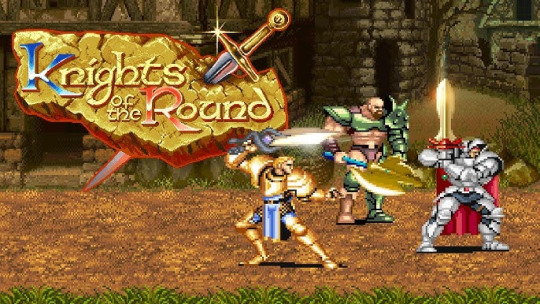
Knights of the rounds gameplay is very similar to other Capcom beat 'em ups. There are seven stages, each with its own boss and a variety of generic enemies that try to stop the players' progress.
2. The Simpsons (video game)
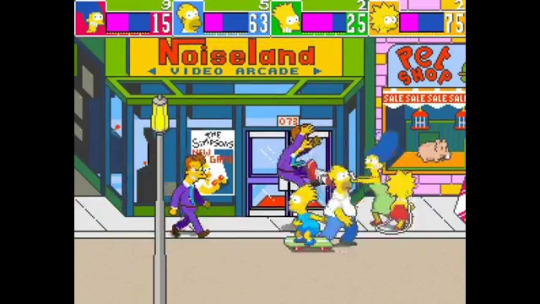
in The Simpsons the recognizable family have to fight through waves of enemies across 8 stages to get Maggie after she accidentally takes the diamond from mister burns leading to her being kidnapped by Mr. burns.
3. Dungeons & Dragons: Tower of Doom
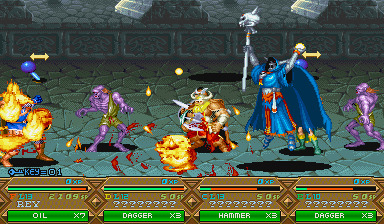
Tower of Doom is a side-scrolling arcade game featuring four playable characters, a cleric, dwarf, elf and a fighter with classic Dungeons & Dragons monsters as opponents. At points in the game the players are given a choice of paths to take to continue with their game. Each path goes to a certain areas , and it is impossible to visit every area in a single playthrough.
Interactive
HOOPS
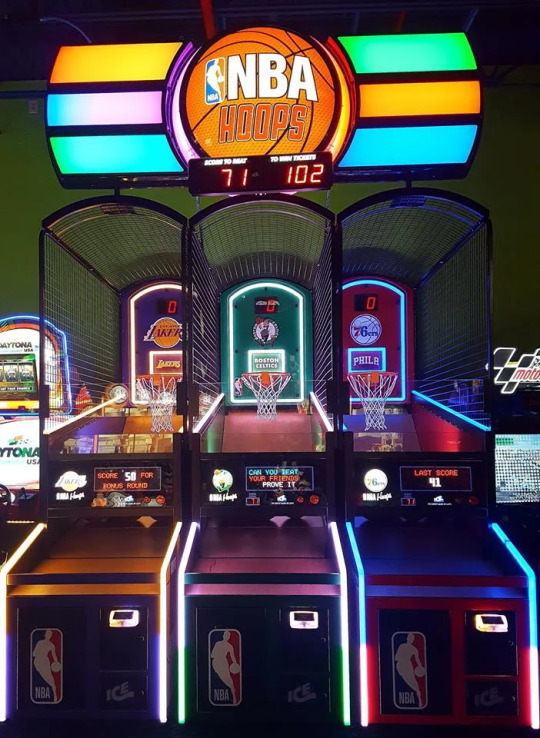
NBA hoops is a interactive game where the player has to score as many points as they can in a set time via throwing the basketball into the hoops.
2. Air Hockey

Air Hockey is a game simular to pong in the fact that it involves you using a mallet to hit a puck to the other side to get it into the goal while trying to stop it from getting into your own goal
3. Skee ball

Skee ball is a game that involves rolling a ball up an inclined and into a ball hoop with different points
0 notes
Text
Let's take a closer look at the hominin skulls in the Senckenberg Museum's human evolution room. Keep in mind this is not a linear progression through our ancestors, and more like a bunch of closer and more distant cousins.


The first one, Sahelanthropus tchadensis is seven million years old, and may very well not be a hominin at all. I've always leaned towards the hypothesis that it's a gorilla relative, not one of ours. No matter which branch of the apes it belongs to, it lived not long after the time the human-line (hominins) and the chimp-line separated, and possibly even before that point!


Ardipithecus ramidus, the first hominin from where we can start making a fairly decent family tree of our relatives. Before this point, 5 million years ago, hominin fossils are very rare, fragmentary, and difficult to assign. One of the most interesting things that does seem to emerge from these early fossils is that we have walked on two legs for a long time. Maybe even so long that our common ancestor with the chimps and bonobos did it!

Lucy represents Australopithecus afarensis, who shows up at this point (3.3 million years ago).


Australopithecus africanus, the Taung child to be precise. We're about 2.8 million years ago at this point. Australopithecines must've been such fascinating creatures.


Homo habilis, the 'handy man', named that way because when they were discovered they were thought to be the first humans who used tools. Since then, Australopithecus tools have been found, and tool use by many different animals has also been documented.


Homo rudolfensis, a population of humans who lived at the same time as Homo habilis and were notably bigger and a little brainier. Does it warrant being its own species? That depends who you ask. Splitting vs lumping is a point of contention in almost every group's biology, and it can run especially high in the field of human evolution since hominins are A very high profile and important fossils that directly relate to our own origins, and B an extremely tangled group that seems to have produced loads and loads of isolated populations and subspecies that regularly migrated all over the place and had frequent interbreeding events. Personally I tend to come down on the side of lumping them into a few major species.


Paranthropus boisei. These were basically a separate lineage of australopithecines, quite different from our own ancestors, who continued to do australopithecus things until quite recently. They were very good climbers and seem to have returned to the trees.


Homo ergaster, either a close relative or a synonym of the more famous Homo erectus. This is the point where we got really brainy, probably figured out how to make fire ourselves, and spread from Africa to Eurasia.


Homo heidelbergensis. Homo erectus and its many subspecies spread all over Africa and Eurasia and existed for well over a million years. As time marches on and evolution did its thing, we eventually start calling the ones in Africa Homo heidelbergensis. They were quite tall, positively enormous compared to little Lucy a few million years back, and they too joined in the human migrations out of Africa. From the H. heidelbergensis who moved into Eurasia we eventually get neanderthals and denisovans, while Homo sapiens evolved from the heidelbergensis populations in Africa.


And there's the neanderthals! Large-brained and creative (the first known cave paintings belong to them and they buried their dead), they were likely quite different from the brutish image we often get from them. Rather than truly dying out, their populations eventually merged with the larger Homo sapiens population once they migrated out of Africa, leaving our modern genes with a couple percent neanderthal DNA.


Homo sapiens. And that's us! Not so much the last remaining branch of the human family tree as much as several of the separate branches ended up coming back together and weaving into a single bigger branch.


And then there's these little guys, Homo floresiensis! Probably originating from a Homo erectus population that ended up on the island Flores, insular dwarfism ended up making them grow quite tiny. On their isolated island, they remained until about 50000 years ago.
#human evolution#sahelanthropus#ardipithecus#australopithecus#homo#ape#primate#mammal#neogene#quaternary#palaeoblr#senckenberg museum#vicky's vritings
362 notes
·
View notes
Note
Abt the How To Dynamic Paneling, something that also helps is by reading a lot of different comics and seeing how those artists do their layouts and working out their how and whys. Personally I've been rereading (for like the 3rd time after following it since first release lol) Spy x Family and while no spoilers the series is very much a balance between comedy and action, and while no spoilers there's really interesting panels in some of those latter scenes where weapons will break OVER the panel borders to emphasize its power. It's really cool but it's also a function of the particular tone and style of the comic; the comedy and lower stakes moments are often softer with less concrete framing, and I think on some level working out how the paneling happens is something that depends on the actual artist style and medium over most things. Namesake also has some gorgeous layouts
Spy X Family is both very cute and very good at communicating clear action without overloading on speed lines! It also has to juggle the complexities of having a psychic protagonist and making a clear distinction between what she's telepathically sensing vs what's she's thinking on her own vs what people around her are saying vs non-diegetic narration. It also plays with panel borders - in this page from chapter 3 (I'm only gonna use examples for chapter 3 to avoid spoilers) the figures in the second panel fully overlap the first panel, unrestrained by the borders. The third panel, however, fully encloses the figures, speech bubbles and narration box.

They do this with word bubbles a lot, producing an effect similar to how a cut to a wide or environmental shot would work in TV. It implies that the dialogue plays over the unrelated background shot or scene. The narration is also helpfully contained in a different-shaped hard-edged rectangular box, quite distinct from any dialogue or thought bubbles, helping us recognize instinctively that while Anya can hear anything and everything in the rounded bubbles, the narration is firmly separated from in-universe speech and thought.

In this one, the speech bubbles for the loud, angry shouting crowd break the panel borders, signifying how they're overwhelming Anya, in contrast to the other, softer narration and dialogue which is contained within the panel borders.

And this chapter also has an action-heavy page that skews the panel borders to follow the direction of movement, drawing the eye down to the center of the motion! The speed lines and sound effect follow the same perspective rules and don't obscure the background figures. The two panels on the left side contrast the sudden action and extreme movement by showing two timeless or slow-motion moments, signified by the particles (and teeth) hanging suspended in the air - the absence of speed lines indicates to us that these moments are single, frozen vignettes. We know exactly what this scene would look and feel like when animated.
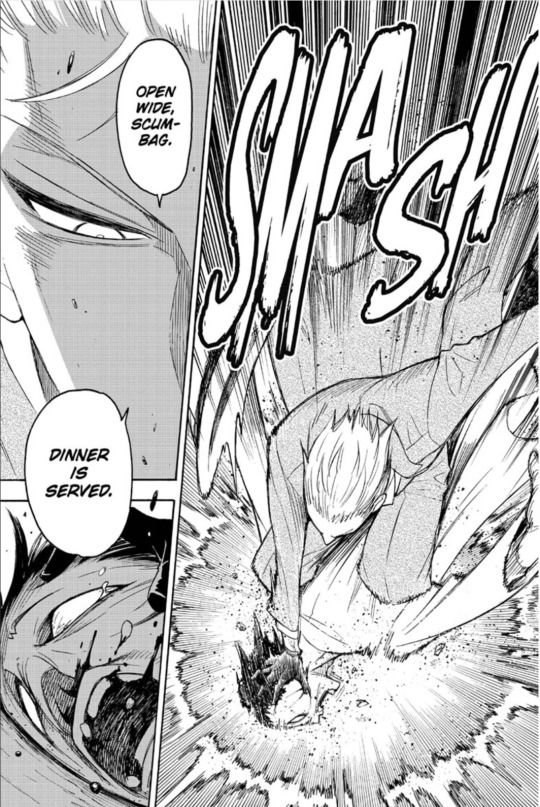
Characters will often overlap panels and borders to signify that they're reacting to or thinking about something in that panel. It's a very efficient way of making the scene feel a little timeless and floaty, since it no longer signifies a strict linear progression of events.

This comic is doing a lot of interesting things with page layouts! I definitely recommend checking it out with an eye for what stylistic rules it follows, what rules it breaks, when it breaks them and why.
Also just read more comics in general. Can't stress that enough. It's win-win.
106 notes
·
View notes
Text
funniest bridget denialist in the world was found in the Woolie vs Guilty Gear vid where he was practicing Bridget and there was one dude in the comments responding to like every single mention of her pronouns with an excerpt from the game manual from Guilty Gear X2 about her gender situation
GG X2
the one that was released in 2003
the one that has had three sequels and like 8 remakes/remasters after it
linear progression of time is hard to understand for people who never leave their houses i guess
#[wakes up from a coma] oh boy i cant wait to see how my favorite character from the original gg doctor baldhead is doing#oh#oh no
9 notes
·
View notes
Text
I’m currently in the process of beating Pyre and making my way to Hades’ epilogue, but today a video came up in my YouTube recommended highlighting Hades’ extensive dialogue system. It’s one of my favorite features of the game, so naturally, I happily watched it (and here is a link for you to check it out yourself)
But one thing I was surprised to see is how closely Hades’ dialogue system came from Pyre’s. In fact, a developer even says word for word that Hades wouldn’t have even happened without Pyre setting the precedent for that dialogue system for Supergiant.
Pyre, much like Hades, plays heavily off of player experience making it a unique story that loosely follows the same general plot for everyone. Everybody starts at the same point, but the game quickly branches out based on YOUR choices. In Pyre, you liberate characters one by one. So, if I liberate Jodi first, my game is automatically going to not have dialogue experiences someone who kept Jodi longer will have, and at the same time, include experiences that will only occur if Jodi isn’t present (or at least is more likely without her there).
And even with liberations aside, there are probably differences for people who win every rite, vs. people who win some but not all, vs. people who lose all of them. That alone can cause the game to be a vastly different experience from just those 3 differences between the playthroughs. Hades works similarly, where you start at the same point (in a run, and every player receives Athena as their first Olympian boon), but quickly breaks down based on choices and player-specific actions. One thing that really struck me however, is how both games play so much off of losing.
Hades has COUNTLESS dialogue and experiences based on if you die, how you die, how far you made it before you died, who or what caused your death, etc. You could argue that you arent even getting the full experience of the game unless you die a countless amount of times.
Pyre is a game where you can’t die, but you can lose. I was shocked to discover it isn’t like Bastion or Transistor (other Supergiant games), with more linear plots. If you lose, you get a gameover and just try again until you succeed. Pyre, however, goes, “Oh, we lost? Well, there is no choice but to keep moving forward.” There is no, “game over.” There is only more progress to be made. You can have an ending of the full story where you lose every single rite you ever participate in. This probably presents a wide variety of dialogue you will not see if you didn’t lose this much, if at all. I’m fairly certain a dev in the video above even says Pyre has somewhere around 2 million dialogue instances that are impossible to see with just one playthrough.
I just really think it’s interesting to think about these games and these concepts of these heavily immersive and player-unique experiences, ESPECIALLY ones that play off of what we would usually consider failure.
40 notes
·
View notes
Text
Mario Kart x Crawl: Multidimensional Progression vs. Linear/Additive Progression
Dialogical Analysis
Mario Kart's an alright game, but in terms of actual design its so agonisingly boring to me. like, ok, you want to be a party game that uses negative feedback loops to engage players regardless of skill level? dope, we love it, go off. what's that? the loops are only implemented through an item economy that directly and heavily punishes other players? I'm going to vomit.
It's an ok idea, and its certainly great at teaching basic multiplayer design, but party games have since made leaps and bounds in how losing players are engaged.
I'm gonna shout out one of my favourite party games: Powerhoof's Crawl. It's definitely not entirely comparable to Mario Kart in terms of gameplay and scope, but the developers are so good at the emergent balancing Nintendo tries to create.
The best term I can think of to describe Crawl's gameplay is symmetrical-asymmetrical. One player is the "hero", and the others are ghosts who try to kill them. When the player is killed, whoever killed them becomes the new hero. Only the hero can win the game, but the ghosts have access to a large selection of enemies and traps (including in the final boss fight).
The reason it's so good is that both the hero and the ghosts level up throughout the game, which makes it increasingly hard for a single player to lead the whole time. Bad players still get to play in the foreground, and will naturally get an advantage in combat if they're unable to become the hero. Players who stay the hero for a long time are going to have an under-levelled ghost, which gives other people a chance to be the hero when they die.
Good players will still win more often, and gameplay still requires skill to succeed, but losing players aren't going to be completely abandoned as soon as they make a mistake.
Mario Kart is permanently married to a massive positive feedback loop in that players are moving forward; each success or failure builds on the previous. This type of progression, which I'm calling linear/additive progression, is naturally antithetical to party games, since all gameplay encounters can only impact the game through a single dimension. Stuff like the blue shell is so inherently frustrating because the only way to limit good players' progress is by stopping them in their tracks.
In contrast, Crawl's asymmetrical hero/ghost gameplay loops create a second dimension of progression. The hero can interact with the main form of progress (the boss), but is entirely cut off from the secondary form of progress (levelling up their ghost).
tl;dr Mario Kart is built on a linear progression system (racing) that stops it from being able to seriously balance out skill gaps between players. Crawl has a secondary independent type of progress available to players who aren't in the lead, which naturally de-emphasises the importance of the main progression loop.
2 notes
·
View notes